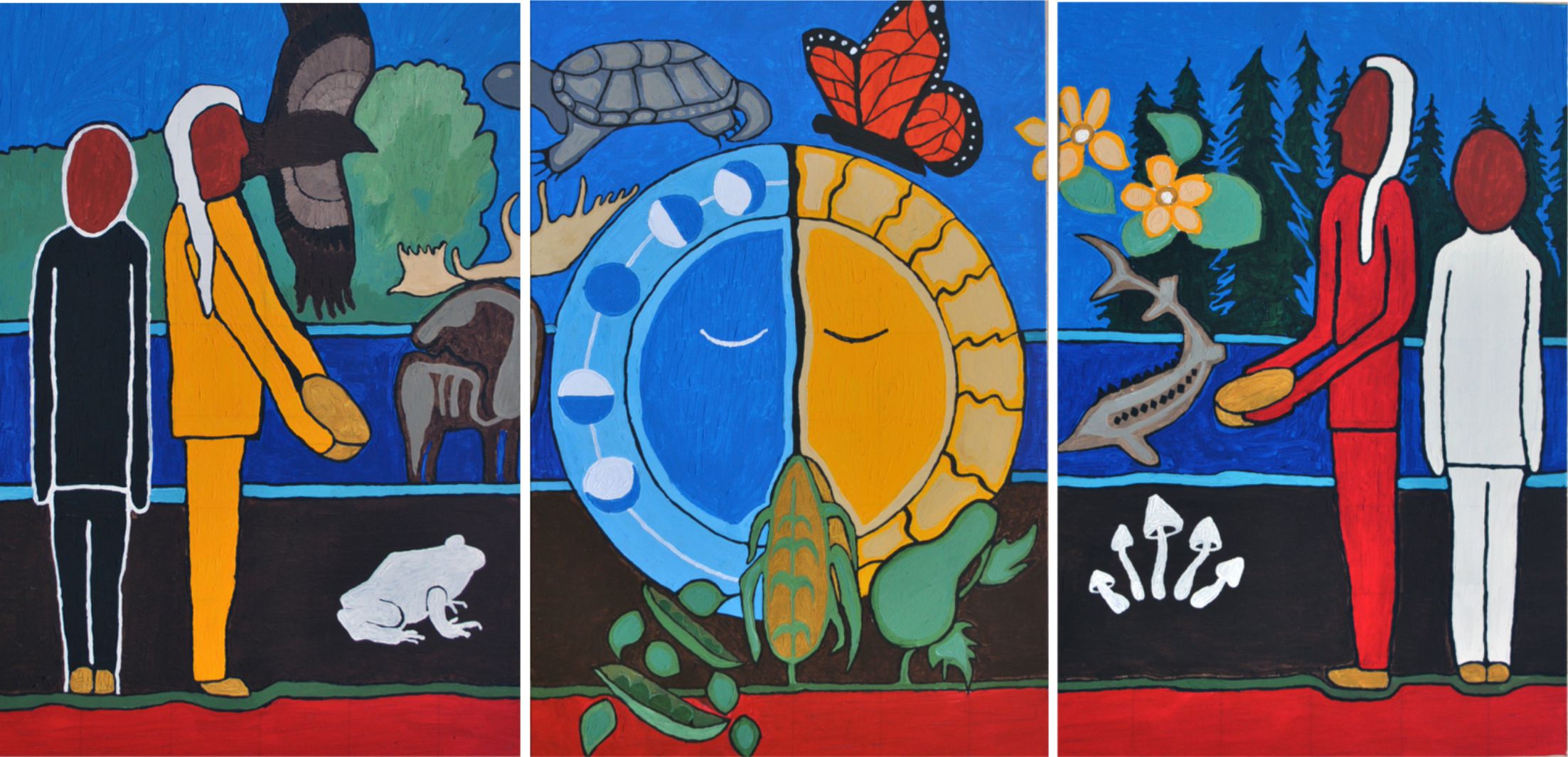
“Gifts from Mother Earth,” presented to the Municipality of North Grenville by local artist Finian Paibomesai in 2022.
The original mural is on display in the front lobby of the North Grenville Municipal Centre.
Gifts from Mother Earth
This artwork shows what Mother Earth has to offer to all living things to be able to survive and continue the life’s cycle. Continued abuse of Mother Earth will make a desolate waste land. Mother Earth must heal and humankind must be grateful for its gifts.
The background colours represent the four elements:
- Light Blue (wind and atmosphere) Dark Blue (water) Brown (soil) Red (fire)
- The four human figures are the cardinal points and sacred circle
- White: North, Air, White skinned People, Stars, Midnight, Death, Winter, Intellect – Mind, Animal, Sweetgrass.
- Yellow: East, Fire, Yellow skinned People, Sun, Dawn, Growth, Spring, Emotional – Heart, Mineral, Tobacco.
- Red: South, Water, Red skinned People, Moon, Noon, Birth, Summer, Spiritual – Soul, Plant, Cedar.
- Black: West, Earth, Black skinned People, Dusk, Maturity, Autumn, Physical – Body, Human, Sage.
Each of the other images represent: Sturgeon (water), Flowers (ground cover), Butterfly (insects), Turtle (Reptiles), Eagle (Birds), Moose (Animals), Bull frog (Amphibians), Mushroom (under ground), Coniferous and Deciduous trees.
About the Author: Finian Aloysuis Paibomesai
Finian is a member of the WhiteFish River First Nation (Manitoulin Island). He came to the Ottawa area in the early 1970s to study Fine Arts at Algonquin College, University of Ottawa and Ottawa School of Art. At Algonquin College in the Visual Arts Program, he was taught by Fred Maheux, Pat Durr, Sima Vinburg, Lucille Yang, Dale Dunning, Richard Nigro, Rose Marie Swingle and other teachers. After graduating from Algonquin, he attended the University of Ottawa in the Bachelor of Arts (Fine Arts) and was instructed by Richard Gorman, Jim Boyd, Michael Schreyer, Phillip Frye and Richard Simmons.
In his formative years, Finian experimented with a lot of art styles from realism to abstract using oils, acrylic, ink and watercolour.
In the early 1980s, Finian and his wife Lynn moved from Ottawa to South Gower, a rural setting to develop and nurture his distinctive art style. Live many artists, to help him with his artistic journey, Finian had to rely on other sources of income eventually opening his business, fp Creative Solution Graphic Design, Signs and Decals.
Artist’s Statement:
“Artistic Inspiration happens in different forms, so I do mine with lines…”
My artwork is developed through a mental visual image which is then sketched to a flat surface such as paper, canvas or Masonite board. The process is started with a line that traces out the outline of a perceived image. The image is then filled using lines (eg. Brush strokes loaded with paint). Even if there is a form of controlled application of the medium, each piece changes and evolves with selection of lines and colour as it is being produced. The finished composition is accompanied with vivid colours, abstract marks, spots, swirls and strokes. This is where the view is drawn into a contemplative space of real and spiritual world.
Steps in the use of lines (1) Visualizing the image. (2) Initial layout on the surface. (3) Application of the media. (4) Signing of the art piece.
First Nations Artist Evolution:
Stories for the First Nations Peoples have always been a major tool of cultural transmission, holding the story, values, beliefs and spirituality of the people. Through their paintings, First Nation Artists transcends the verbal storytelling history of their People that enters into the realm of visual arts. In this, First Nation Artists hope their work will resonate and awaken an awareness that is at once exciting and empowering, a way for all people to understand an Aboriginal world view. Within this context, story telling through colour and imagery, First Nation Artist’s work will contribute to cultural revitalization, an awakening that continues to gather strength among the people to express and share the experience of being in and with the world, not masters of it.
The Municipality of North Grenville is committed to a meaningful reconciliation process, which will include engagement of the Indigenous community to better understand the actions that need to be taken.
We can all take steps to raise understanding about residential schools and the ongoing effect on Indigenous Peoples.
The Truth and Reconciliation Commission (TRC) published its final report in 2015 to create a historical account of the residential schools, help people to heal, and encourage reconciliation between Indigenous and non-Indigenous Canadians.
The Municipality of North Grenville is committed to carefully reviewing and implementing recommendations outlined in the Truth and Reconciliation Commission’s (TRC’s) Calls to Action.
Several recommendations from the 2015 Commission were focused on the role that municipal governments can play, such as:
- Training on Indigenous issues for municipal staff and Council (in progress)
- Raising of the Every Child Matters Flag on September 30th
- Recognition of key Indigenous dates (listed below).
- Development of a land acknowledgment, in consultation with local Indigenous leaders (adopted in February 2022)
- Public engagement sessions with Indigenous and non-indigenous community members (in progress)
North Grenville's Land Acknowledgement: (updated by Council on December 5, 2023)
The Municipality of North Grenville acknowledges that the Municipality operates on the territory of the Anishnabek.
We recognize all First Nations, Métis, and Inuit peoples who now call North Grenville their home. We respect and support the need for cultivating a strong relationship, and we commit to Indigenous-informed decision making to foster the path towards reconciliation.
The Municipality, in partnership with the Indigenous advisory firm First Peoples Group and community partners, is currently creating a reconciliation framework. The process includes assessing current policies, procedures, and strategic documents through a reconciliation lens.
The draft Framework will be brought to the newly established Indigenous Advisory Circle who will decide on next steps.
Mino-jichaag Mtigwaaki Garden
 Mino-jichaag Mtigwaaki (pronunciation: minnow che gaak matig waa ke, translation: Good Spirit Forest) is a collaboration of The Ferguson Forest Centre Corporation, the Municipality of North Grenville’s Indigenous Advisory Circle, and Indigenous community members.
Mino-jichaag Mtigwaaki (pronunciation: minnow che gaak matig waa ke, translation: Good Spirit Forest) is a collaboration of The Ferguson Forest Centre Corporation, the Municipality of North Grenville’s Indigenous Advisory Circle, and Indigenous community members.
The site was designed by local artist Finian Paibomesai in a manner that honours the culture, traditions, and history of the area which is part of the Algonquin territory. Mino-jichaag Mtigwaaki is based on the medicine wheel which is symbolic of the four elements fire, earth, water, and wind. It is a welcoming and open space that is used to celebrate Anishinaabe culture and as a site for events.
The initial phase of the site has been completed, which involved building the gardens, laying the crushed stone, adding a fire pit, and placing the 7 rock benches (symbolic of the Seven Grandfathers of Anishinaabe teachings). During the next phase we will add signage, more plants of cultural and medicinal significance, and ultimately a permanent adjacent structure so that events can be held in all-weather.
For more information about the current plants click here (coming soon).
Address: 241 Honour Way, Kemptville
-
June 2025
-
November 2024
-
September 2023
-
September 2022
-
February 2022
-
September 2021
- Read the Truth and Reconciliation Commission’s Calls to Action: The Truth and Reconciliation Commission (TRC) provided those directly or indirectly affected by the legacy of the Indian Residential Schools system with an opportunity to share their stories and experiences. Learn more including the Commission’s 94 Calls to Action.
- National Inquiry into Missing and Murdered Indigenous Women and Girls
- Indigenous Reads: List of recommended books written by Indigenous writers (CBC)
- The National Film Board of Canada (NFB) offers a rich online collection of Indigenous-made films through Indigenous Cinema , a website that provides free streaming of more than 200 film titles
Key Dates
National Ribbon Skirt Day in Canada is a day to learn more about and to celebrate Indigenous culture, traditions, histories and contributions.
While this day was only recently established, ribbon skirts are traditionally worn by First Nations and Métis peoples and are a centuries-old symbol of identity, adaptation and survival for Indigenous women, girls and gender-diverse people.
Contact
Hillary Geneau
Director of Corporate Services

